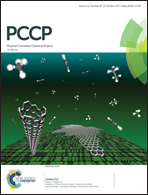Could the increased structural versatility imposed by non-halogen ligands bring something new for polynuclear superhalogens? A case study on binuclear [Mg2L5]− (L = –OH, –OOH and –OF) anions†
Abstract
A combined ab initio and DFT study is performed in this work to explore the superhalogen properties of polynuclear structures based on the ligands of –OH, –OOH and –OF. According to high-level CCSD(T) results, all the structures here are superhalogens whose properties are superior to the corresponding mononuclear ones. Although inferior to similar structures based on F ligands, some of the superhalogens here are capable of transcending the traditional ones based on Cl atoms. Therefore the superhalogen properties of the anions here are still promising and they have an important advantage of high safety, which is crucial for practical applications. An increased degree of structural versatility is imposed by these non-halogen ligands because of the various ways in which they connect the central atoms and their multiple orientations. It is important that this increased versatility will bring new factors, e.g., the larger spatial extent of the whole cluster and the existence of intra-molecular hydrogen bonds, which should favour high VDE values. These factors are not available in traditional halogen-based systems and they may play an important role in the future search for novel superhalogens. (HF + MP2)/2, ωB97XD as well as M06-2X are capable of providing accurate VDE values, close to the CCSD(T) results, and their absolute errors are even lower than that of the OVGF. Due to the good balance between the accuracy and efficiency, these methods could provide reliable predictions on large systems which cannot be treated with CCSD(T) or even with the OVGF. Balanced distribution of the extra electron, between the terminal and bridging ligands, is also shown to be favourable to realize a high VDE value.
![Graphical abstract: Could the increased structural versatility imposed by non-halogen ligands bring something new for polynuclear superhalogens? A case study on binuclear [Mg2L5]− (L = –OH, –OOH and –OF) anions](/en/Image/Get?imageInfo.ImageType=GA&imageInfo.ImageIdentifier.ManuscriptID=C7CP05037B&imageInfo.ImageIdentifier.Year=2017)


 Please wait while we load your content...
Please wait while we load your content...